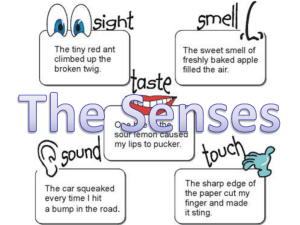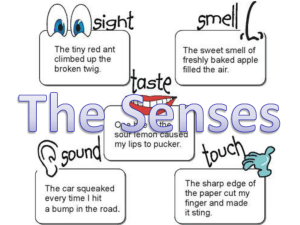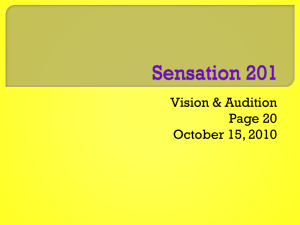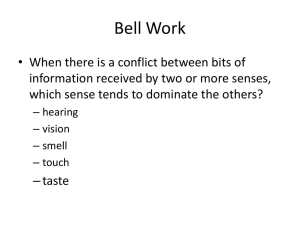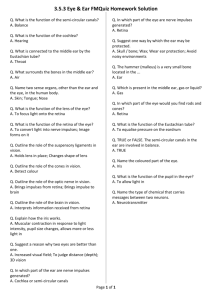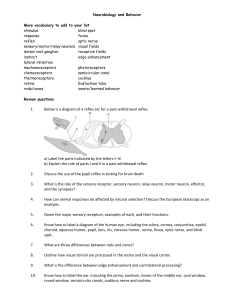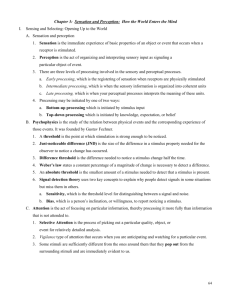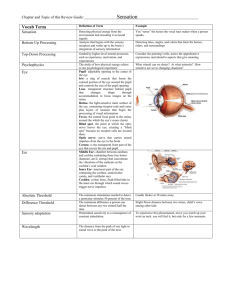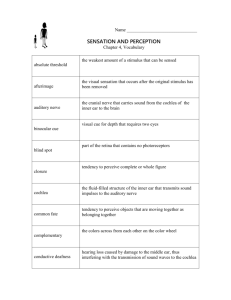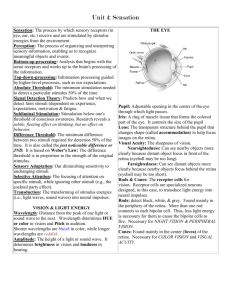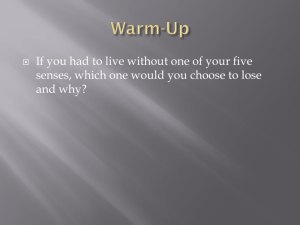Unit 4 Sensation
advertisement
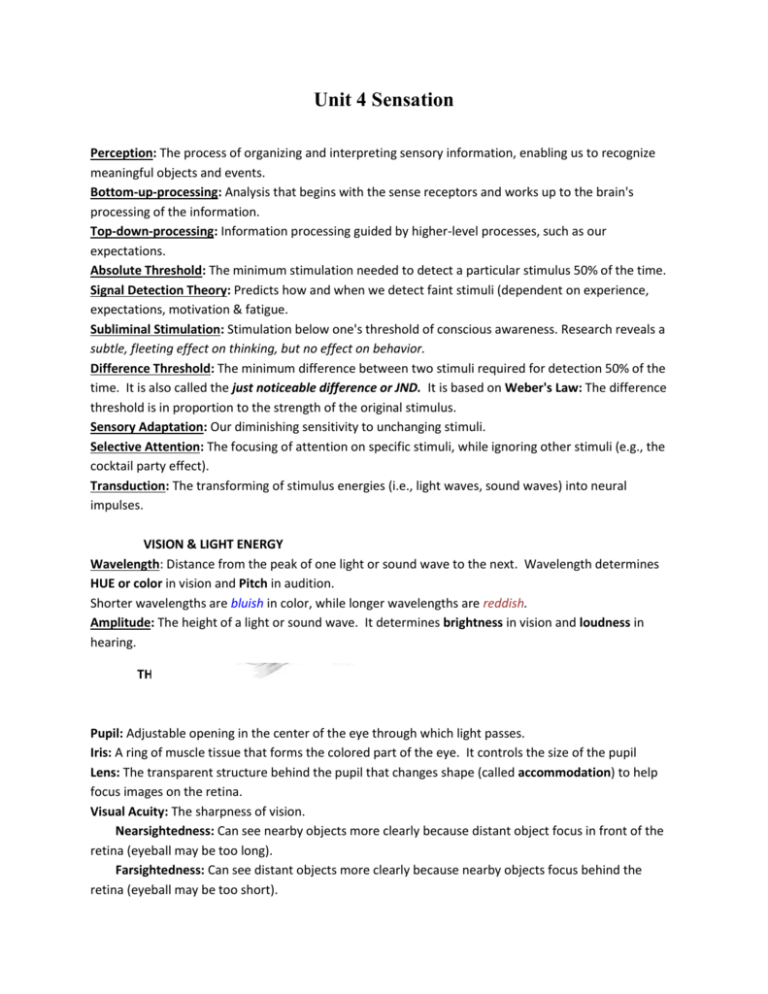
Unit 4 Sensation Perception: The process of organizing and interpreting sensory information, enabling us to recognize meaningful objects and events. Bottom-up-processing: Analysis that begins with the sense receptors and works up to the brain's processing of the information. Top-down-processing: Information processing guided by higher-level processes, such as our expectations. Absolute Threshold: The minimum stimulation needed to detect a particular stimulus 50% of the time. Signal Detection Theory: Predicts how and when we detect faint stimuli (dependent on experience, expectations, motivation & fatigue. Subliminal Stimulation: Stimulation below one's threshold of conscious awareness. Research reveals a subtle, fleeting effect on thinking, but no effect on behavior. Difference Threshold: The minimum difference between two stimuli required for detection 50% of the time. It is also called the just noticeable difference or JND. It is based on Weber's Law: The difference threshold is in proportion to the strength of the original stimulus. Sensory Adaptation: Our diminishing sensitivity to unchanging stimuli. Selective Attention: The focusing of attention on specific stimuli, while ignoring other stimuli (e.g., the cocktail party effect). Transduction: The transforming of stimulus energies (i.e., light waves, sound waves) into neural impulses. VISION & LIGHT ENERGY Wavelength: Distance from the peak of one light or sound wave to the next. Wavelength determines HUE or color in vision and Pitch in audition. Shorter wavelengths are bluish in color, while longer wavelengths are reddish. Amplitude: The height of a light or sound wave. It determines brightness in vision and loudness in hearing. THE EYE Pupil: Adjustable opening in the center of the eye through which light passes. Iris: A ring of muscle tissue that forms the colored part of the eye. It controls the size of the pupil Lens: The transparent structure behind the pupil that changes shape (called accommodation) to help focus images on the retina. Visual Acuity: The sharpness of vision. Nearsightedness: Can see nearby objects more clearly because distant object focus in front of the retina (eyeball may be too long). Farsightedness: Can see distant objects more clearly because nearby objects focus behind the retina (eyeball may be too short). Rods & Cones: The receptor cells for vision. Receptor cells are specialized neurons designed, in this case, to transduce light energy into neural impulses. Rods: detect black, white, & grey. Found mainly in the periphery of the retina. More than one rod connects to each bipolar cell. Thus, less light energy is necessary for them to cause the bipolar cells to fire. Necessary for NIGHT VISION & PERIPHERAL VISION. Cones: Found mainly in the center (fovea) of the retina. Necessary for COLOR VISION and VISUAL ACUITY. Light waves stimulate rods & cones which synapse to bipolar cells, which synapse to ganglion cells. The axons of the ganglion cells come together to form the Optic nerves which transmit visual information to the brain. Blindspot: The area in the retina where the optic nerve leaves the back of eye. No rods or cones are located there, so no vision is possible at that location. Feature Detectors: Nerve cells in the brain that respond to specific features of a visual stimulus, such as shape, angle, or movement. Parallel Processing: The ability of the brain to process several aspect of a situation simultaneously. COLOR VISION Young-Helmholtz Trichromatic Theory: The theory that the retina contains three different types of cones--one most sensitive to red, one to blue, and one to green--which when stimulated in combination can produce any color. RED, GREEN, & BLUE are the PRIMARY COLORS OF LIGHT WAVES. Opponent Process Theory: Theory that opposing retinal processes (red-green, yellow-blue, & blackwhite) enable color vision. For example some cells are stimulated by red while inhibited by green; others are stimulated by yellow, while inhibited by blue. This helps explain afterimages. Color constancy: Perceiving familiar objects as having consistent color, even if changing illumination alters the wavelength reflected by the object. AUDITION Audition: The sense of hearing. Frequency: The number of complete wavelengths in a given period of time. Frequency determines pitch. Amplitude: Height of each wavelength--determines loudness. Sound Localization: Sound waves strike one ear sooner and with more intensity than the other ear. With this information, the brain can determine the location of the sound. Middle Ear: Chamber between the eardrum and the oval window which contains the ossicles (three tiny bones--hammer, anvil, & stirrup) which concentrate the vibrations of the eardrum. Inner Ear: Contains the cochlea, semicircular canals, and vestibular sacs. Cochlea: a coiled, bony, fluid-filled tube through which sound waves trigger nerve impulses. Basilar Membrane: Membrane along the center of the cochlea that contains hair cells (the receptor cells for sound). Axons from the hair cells for the Auditory Nerves, which transmit neural impulses to the brain. PITCH PERCEPTION Place Theory: Theory that the pitch we hear is associated with the place where the basilar membrane is stimulated. Best for explaining high-pitched tones. Frequency Theory: Theory that the rate of nerve impulses traveling up the auditory nerve matches the frequency of the tone we are hearing. Best for explaining low-pitched tones. Volley Principle: Helps explain in frequency theory how we can hear sounds with a frequency greater than 1000 cycles per second. While some neurons are "recharging" during the refractory period, others are firing. Conduction Deafness: Caused by damage to the structures that conduct sound waves through the ear (eardrum, ossicles). Nerve Deafness: Caused by damage to the cochlea's hair cells or the auditory nerve. TOUCH Touch or tactile sense involves a mixture of at least 4 distinct skin senses--pressure, warmth, cold, and pain. Only pressure has identifiable sense receptors. COLD + PRESSURE = WETNESS COLD + WARMTH = HOT PAIN Gate-Control-Theory: Theory that the spinal cord contains a neurological "gate" that blocks pain signals or allows them to pass. The gate is opened by stimulation of small nerve fibers and closed by stimulation of larger fiber or by information coming from the brain. TASTE Taste is the Gustatory Sense. Taste is a CHEMICAL SENSE and consists of the four basic tastes of sweet, sour, bitter, & salty. There may also be a 5th sense called "umami" or a meaty taste. Each bump on the tongue contains over 200 taste buds. Each bud contains a pore that captures food molecules. The molecules cause hair-like neurons within the pores to fire. Taste Buds reproduce themselves every 2-3 weeks. Sensory Interaction: The principle that one sense may be influenced by another, as when the smell of food influences its taste. SMELL Smell is the Olfactory Sense. Smell is also a CHEMICAL SENSE. Very little is known about the olfactory sense. However, we are able to detect about 10,000 different odors. Smells are processed in the temporal lobes of the brain and in the LIMBIC SYSTEM, which may explain why certain smells seem to have an emotional component and can trigger memories. Molecules in the air reach millions of receptor cells in each nasal cavity. These cells send messages to the olfactory bulb and the olfactory nerve which transmits the messages to the brain. BODY POSITION & MOVEMENT Kinesthesis: The system for sensing the position and movement of individual body parts. The receptor cells for kinesthesis are found in our muscles, tendons, & joints. Vestibular Sense: The system that monitors the head's (and thus the body's) position and movement. It is our sense of equilibrium. The semicircular canals and vestibular sacs in the inner ear contain receptors that tell us about our head's position.
